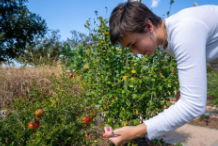Tomato leaves will begin showing signs of leaf-spot diseases soon if they haven’t already, Kansas State University horticulture expert, Ward Upham said. Brown spots on the leaves indicate Septoria leaf and blight.
“Septoria leaf spot usually appears earlier in the season than early blight and produces small dark spots,” Upham said. “Spots made by early blight are much larger and often have a distorted “target” pattern of concentric circles.”
Upham said heavily infected leaves will turn yellow and drop, with older leaves being more susceptible than young leaves because the disease starts at the bottom of the plant and works its way up.
“Mulching, caging, or staking keeps plants off the ground, making them less vulnerable. Better air circulation allows foliage to dry quicker than on plants that are allowed to sprawl,” Upham said.
He recommends mulching to prevent water from splashing and carrying disease spores to the plant.
If you have room, rotate the location of the tomatoes each year to an area that has not had tomatoes or related crops (peppers, potatoes, eggplant) for several years, Upham suggests.
“In situations where these diseases have been a problem in the past, rotation is a good strategy,” Upham said. “Rotation is a good idea even if you have not had problems in the past, although many gardens are too small to make it practical.”
If rotation is not feasible, Upham said fungicides are often helpful. Be sure to cover both upper and lower leaf surfaces, and reapply fungicide if rainfall removes it.
“Plants usually become susceptible when the tomato fruit is about the size of a walnut. Chlorothalonil is a good choice for fruiting plants because it has a zero-day waiting period, meaning that fruit can be harvested once the spray is dry,” Upham explained.
Chlorothalonil can be found in numerous products including Fertilome Broad-Spectrum Landscape and Garden Fungicide, Ortho Garden Disease Control, GardenTech Daconil, Bonide Fungonil and others.
“Be sure to start protecting plants before these diseases are first seen if they have been a problem in the past. It is virtually impossible to control these diseases on heavily infected plants,” Upham said.
Upham and his colleagues in K-State’s Department of Horticulture and Natural Resources produce a weekly Horticulture Newsletter with tips for maintaining home landscapes and gardens. The newsletter is available to view online or can be delivered by email each week.
Interested persons can also send their garden and yard-related questions to Upham at wupham@ksu.edu, or contact your local K-State Research and Extension office.
Ward Upham, Extension Agent




